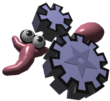| 1 | // This file is a part of the Framsticks GDK. |
|---|
| 2 | // Copyright (C) 2002-2014 Maciej Komosinski and Szymon Ulatowski. See LICENSE.txt for details. |
|---|
| 3 | // Refer to http://www.framsticks.com/ for further information. |
|---|
| 4 | |
|---|
| 5 | #include "conv_fF.h" |
|---|
| 6 | #include "fF_genotype.h" |
|---|
| 7 | #include <frams/model/model.h> |
|---|
| 8 | #include <common/nonstd_stl.h> |
|---|
| 9 | |
|---|
| 10 | GenoConv_fF0::GenoConv_fF0() |
|---|
| 11 | { |
|---|
| 12 | name = "7-value Foraminifera encoding"; |
|---|
| 13 | in_format = 'F'; |
|---|
| 14 | out_format = '0'; |
|---|
| 15 | mapsupport = 0; |
|---|
| 16 | } |
|---|
| 17 | |
|---|
| 18 | SString GenoConv_fF0::convert(SString &in, MultiMap *map) |
|---|
| 19 | { |
|---|
| 20 | fF_growth_params gp; |
|---|
| 21 | if (!gp.load(in)) //invalid input genotype? |
|---|
| 22 | return ""; //so we return an invalid f0 genotype |
|---|
| 23 | Model m; |
|---|
| 24 | m.open(); |
|---|
| 25 | // subsequent parts (chambers) are placed relative to the previous part's orientation and location |
|---|
| 26 | Part *p1, *p2; |
|---|
| 27 | p1 = m.addNewPart(Part::SHAPE_ELLIPSOID); //initial part |
|---|
| 28 | Pt3D scaling(gp.scalex, gp.scaley, gp.scalez); |
|---|
| 29 | p1->scale = scaling; |
|---|
| 30 | |
|---|
| 31 | Orient rotation = Orient_1; //must be initialized explicitly because the default Orient constructor does not initialize anything |
|---|
| 32 | rotation.rotate(Pt3D(0, gp.angle1, gp.angle2)); //assumed rotation around x is 0, which is limiting if we use assymetrical shapes (i.e., not spheres). But the original model had only two angles... |
|---|
| 33 | |
|---|
| 34 | for (int i = 1; i < gp.number_of_chambers; i++, p1 = p2) |
|---|
| 35 | { |
|---|
| 36 | p2 = m.addNewPart(Part::SHAPE_ELLIPSOID); |
|---|
| 37 | p2->scale = p1->scale.entrywiseProduct(scaling); //each part's scale is its predecessor's scale * scaling |
|---|
| 38 | |
|---|
| 39 | p2->setOrient(p1->o.transform(rotation)); //rotation transformed by p1 orientation |
|---|
| 40 | |
|---|
| 41 | // Part's tip (offset from the center) is the point at (scale.x,0,0) in part's local coordinates. |
|---|
| 42 | // Get the offset in global coordinates by transforming it by the part's orientation. |
|---|
| 43 | p2->p = p1->p |
|---|
| 44 | + p1->o.transform(Pt3D(p1->scale.x*gp.translation,0,0)) // p1's tip transformed |
|---|
| 45 | + p2->o.transform(Pt3D(p2->scale.x*gp.translation,0,0)); // p2's tip transformed |
|---|
| 46 | |
|---|
| 47 | m.addNewJoint(p1, p2, Joint::SHAPE_SOLID); //all parts must be connected |
|---|
| 48 | } |
|---|
| 49 | m.close(); |
|---|
| 50 | return m.getF0Geno().getGene(); |
|---|
| 51 | } |
|---|
